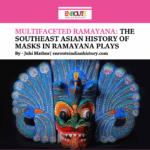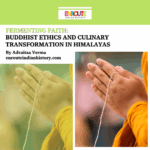Sheetla Saptami was the festival when the chulha and later the modern-day stove was debarred from use. Oliya (curd and rice), Amchur, Mewadi Kachri and Ker Sangri were the delight for the day. Served cold with various chutneys, a tangy taste and an aroma that fills the household, Kair Sangri or Panchkuta was the most sought after and expensive delight out of the lot. A Marwari restaurant in New Delhi serves one person with Ker Sangri for 495/- with the poetic tagline “exotic preparation of Kair berries and Sangri bean with yogurt.” From being a famine crop to a mandatory dish in every Marwari Fat Indian wedding, Ker Sangri has surely come a long way. Its journey to top notch restaurant menus as something “exotic” and the simultaneous endangering of the Khejri tree which is the source plant of sangri makes its retelling worthwhile. The ingredients of this delight have an oral history of two millennials. The two major source plants of this dish are the Capar tree (Kair) and Khejri tree. These trees or bushes have an oral history of two millennia. It was under the Khejri tree that Pandavas hung their celestial weapons during their exile in disguise and Rama . It is under the Khejri tree that these stories are retold after the dinner of dry rotis and native Panchkuta. This article traces the cultural and ecological relevance of these source trees and their significance in the arid desert of Rajasthan.

Sheetla Saptami was the festival when the chulha and later the modern-day stove was debarred from use. Oliya (curd and rice), Amchur, Mewadi Kachri and Ker Sangri were the delight for the day. Served cold with various chutneys, a tangy taste and an aroma that fills the household, Kair Sangri or Panchkuta was the most sought after and expensive delight out of the lot.
The Caper Tree
In the sandy terrain of Rajasthan, the Kair tree of The Caper bush is a canopy to the residents and fauna amidst shifting sand dunes and the heat of Thar. This dense canopy is called “moors”. In the middle of this seemingly inhospitable ecosystem where temperature crosses 50°C in peak summers, Ker tree stands as a symbol of resistance.
Kair belongs to the Capparidaceae (Caper) family. It can grow as a tree or a shrub depending on the external circumstances provided to the seed. The tree is native to several countries including Chad, Ethiopia, Egypt, Iran, Jordan,Nigeria, Pakistan, India, Sudan and much of the Mediterranean basin extending to east of Central Asia.Being a drought-resistant tree it doesn’t wilt for two to three years in spite of low or no rain. From its wood to the nectar of kair flowers, it has something for everyone. It is the survival mechanism of the tree that makes it a standalone. The Caper Tree bears the fruit two to three times in a year between March to April, May to July and October to November. The heaviest fruiting occurs right before the monsoon or during famines. A popular saying goes, “akal kehta he me saat baar paduga, Kair kehta he me saat baar khiluga.” (When the famine says I’ll come seven times this year, the Caper Tree replies I’ll bloom seven more times.) The tangy Ker berries of the Capar tree are used in the making of Ker Sangri.
Genesis of Sangri
Sangri is the bean of the endangered Khejri tree, another drought resistant tree of Rajasthan. Rich with potassium, magnesium, calcium,zinc and iron, Sangri is an active cooling agent and often helpful in treating various diseases like asthma and cholesterol. Apart from its popular use in Kair Sangri it is also used in a chutney called Sangri Pachadi which is served with South Indian dishes like Dosa or Idli or plain rice. The historiography of Sangri is intertwined with that of the Khejri tree or the “Wonder tree” or Kalp Taru (benefit of mankind). The tree being a part of the desert culture is revered and worshiped. It was for the Khejri trees that Amrita Devi Bishnoi sacrificed her life with 363 other villagers in 1731. The aroma of this saag has its legacy in the eco-friendly culture of Rajasthan and tribes like Bishnois.

From being a famine crop to a mandatory dish in every Marwari Fat Indian wedding, Ker Sangri has surely come a long way.
The Making of Kair Sangri
Kair Sangri includes these five plant products – ker, sangri, babul fali (kumatiya), gunda and amchur. It is because of this amalgamation that is known in bolis as Panchkuta. The dish owes its flavor to the blending of species and riches that has remained static through centuries in spite of culinary advancements. Dried red chillies and cumin seeds in subtle heat are till date the basic premises of this aromatic delight. The dry ker Sangri is soaked in water and then processed with a Marwadi tadka to balance the tangy flavor. However, despite its authenticity to the Rajasthani household and cuisine Ker Sangri has infused with Pan-Indian dishes like Pulao, Curry and even Parathas. Like the canopy of the Caper Tree the cuisine too is welcoming to all.

A Marwari restaurant in New Delhi serves one person with Ker Sangri for 495/- with the poetic tagline “exotic preparation of Kair berries and Sangri bean with yogurt.”
Today the aroma of Kair Sangri has traveled to the Burrabazar of Kolkata, Khari Baoli of Old Delhi and even Sahukarpet in Chennai. Its legacy continues with culinary experiments and its aroma and raising price is a reminder of the endangered “wonder tree” – Khejri. This Marwari saag is no longer for you an “exotic dish” but rather a connotation of centuries of a mutual relationship between the dessert, its people and its vegetation. Storms will arrive but the flowers of the Caper Tree will keep blooming as long as this relationship is kept intact.
References –
Gera, H.C. 2002. “The Wonders of the ‘Wonder Tree.’” The Tribune, September.
“Https://Roundglasssustain.com/Habitats/Kair-Desert-Rajasthan.” n.d. Roundglasssustain.com. Accessed October 15, 2023. https://roundglasssustain.com/habitats/kair-desert-rajasthan.
“Ker Sangri Heritage: All about Rajasthan’s Tangy Treasure.” n.d. Slurrp. Accessed October 15, 2023. https://www.slurrp.com/article/ker-sangri-heritage-all-about-rajasthans-tangy-treasure-1684313181707.
Reddy, Catherine. 2013. “The Earth of India: All about Kair (Capparis Decidua) in India.” The Earth of India. March 18, 2013. https://theindianvegan.blogspot.com/2013/03/all-about-kair-capparis-decidua-in-india.html.
“The Story of Ker Sangri: Rugged Plants Survive in Deserts; Rich in Nutrition, Medicinal Properties – Different Truths.” 2017. September 5, 2017. https://www.differenttruths.com/travel-getaways/history-culture/food-history-culture/the-story-of-ker-sangri-rugged-plants-survive-in-deserts-rich-in-nutrition-medicinal-properties/.
The Times of India. n.d. “What Is Sangri and Why You Should Add It to Your Daily Diet.” Accessed October 15, 2023. https://m.timesofindia.com/life-style/food-news/what-is-sangri-and-why-you-should-add-it-to-your-daily-diet/photostory/86273276.cms.



















